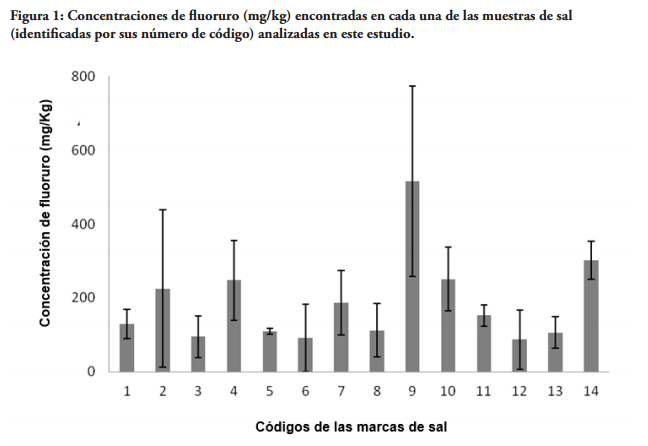Abstract
Objectives: The aim of this study was to evaluate the concentration of fluoride (F)
in household salt marketed in Montevideo, Uruguay.
Methods: Fourteen household salt brands marketed in Montevideo, Uruguay were
analyzed to determine the F concentrations. Salt samples were prepared and F concentrations were determined using a fluoride-specific electrode connected to an ion analyzer.
Results: Most of the salt brands showed values lower than 250 mgF/kg. Coarse salt samples showed higher F concentrations compared to the refined salt samples (p < 0.05). Salt brands contained sodium fluoride presented higher F concentrations than salt brands contained potassium fluoride (p < 0.05). Only two brands had F concentrations close to that informed in product packages.
Conclusions: Household salt brands marketed in Montevideo (Uruguay) present a great variability in their F concentrations.
References
Tenuta LMA, Cury JA. Fluoride: its role in dentistry. Braz Oral Res. 2010; 24 (Suppl 1):9 -17.
Estupiñán-Day S. Promoting oral health: the use of salt fluoridation to prevent dental caries. Washington: PAHO, 2005.
Horowitz HS. Decision-making for national programs of community fluoride use. Community Dent Oral Epidemiol. 2000; 28(5):321–9.
Marthaler T, Petersen P. Salt fluoridation- an alternative in automatic prevention of dental caries. Int Dent J. 2005;55(6):351–8.
Ditterich RG, Rodrigues CK, Wambier DS. [Fluoride salt as a alternative in public oral health: advantages and disadvantages]. Rev Inst Ciênc Saúde, 2005; 23(3): 231-4.
Comisión Honoraria de Salud Bucal. Ministerio de Salud Pública (MSP) Encuesta de Salud Bucal en escolares de 11 a 14 años. Sector Público. República Oriental del Uruguay. 1999.
Martínez-Mier EA, Soto Rojas AE, Buckley CM, Stookey GK, Zero DT, Margineda J. Evaluación del contenido de flúor en la sal de mesa fluorada. Salud Pública Mex. 2004 May-Jun; 46(3):2003-4.
Walsh K I and Cury J A. Fluoride concentrations in salt marketed in Managua, Braz. Oral Res. 2018;32: e45
Hernández-Guerrero JC, Fuente-Hernández J, Jiménez-Farfán MD, Ledesma-Montes C, CastañedaCastaneira E, Molina-Frechero N, et al. Fluoride content in table salt distributed in Mexico City, Mexico. J Public Health Dent. 2008; 68(4):242-5.
Franco AM, Saldarriaga A, Gonzalez MC, Martignon S, Arbelaez MI, Ocampo A. Concentración de fluor en la sal de cocina en cuatro ciudades colombianas. Revista CES Odontología 2003;16: 21-6.
Tovar Valencia S, Castrillon Misnaza S. Perspectiva del uso del flúor vs caries y fluorosis dental. Colombia: Minsalud; 2016 [cited 2017 Sep 29] Disponible en: http://www.minsalud.gov.co/sites/rid/Lists/Bibliotecadigital/RIDE//VS/PP/ENT/perspectiva-uso-fluor.pdf.
Walsh KI, Cury JA. Fluoride concentrations in salt marketed in Managua, Nicaragua.Braz Oral Res. 2018; 24, 32:e45.
Mier EAM, Rojas AES, Buckley CM, Margineda J, Zero DT. Evaluation of the direct and diffusion methods for the determination of fluoride content in table salt. Community Dent Health, 2009; 26(4): 204-10.
Marthaler TM. Salt Fluoridation and Oral Health. Acta Medica Academica, 2013; 42(2): 140-55.
Sagheri D, Mcloughlin J, Clarckson J J. A comparison of dental caries levels in two communities with different oral health prevention strategies stratified in different social classes. Journal of Public Health Dentistry, 2007; 67(1): 1-7.
Fabruccini A, Alves LS, Alvarez L, Alvarez R, Susin C, Maltz M. Comparative Effectiveness Of Water And Salt Community-Based Fluoridation Methods In Preventing Dental Caries Among Schoolchildren. Community Dent. Oral Epidemiol, 2016; 44(6): 577-85.
Mejía R, Espinal F, Vélez H, Aguirre M. Fluoruración de la sal en cuatro comunidades colombianas. VIII. Resultados obtenidos de 1964 a 1972. Bol Oficina Sanit Panam. Colombia, 1976; 80: 205.

This work is licensed under a Creative Commons Attribution-NonCommercial 4.0 International License.


